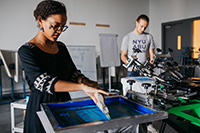-
Academics
-
Admissions
 Your journey to NYUAD starts here. Attend an application workshop or information session.Admissions Events
Your journey to NYUAD starts here. Attend an application workshop or information session.Admissions Events -
Research
-
Campus Life
 Live the possibilities. Be part of a dynamic community of students from over 115 countries.Take a Tour
Live the possibilities. Be part of a dynamic community of students from over 115 countries.Take a Tour - Public Programs
-
About
Exceptional education. World class research. Community-driven.Our Story
- News
- Events
- Social Media Directory
- Press Room
-
- Torch at NYUAD
- Faculty
- Current Students
- Alumni
- عربي
Five Items from the UAE's Early Days
The rarities in NYU Abu Dhabi Library’s Archives and Special Collections are unique materials made available to NYUAD students, faculty, and staff, as well as qualified researchers from the UAE and abroad. Over the years the University has collected such difficult to obtain primary sources that help tell the story of the UAE and provide insight into the country’s history. Through a wide network of diplomats, locals, and historians, the collection is quickly becoming a unique resource to support, enrich, and augment the research interests of students and faculty. Here is a selection of five items from the collections that provide an unparalleled perspective into the birth and growth of the UAE.
Likely to be taken before unification, sometime between 1964 and the early 1970s, these images show Sheikh Zayed meeting with various constituents. Although a prominent Sheikh at this time with global relations and a growing reputation as a visionary leader, Sheikh Zayed is seen here in touch with his Bedouin roots. Meeting with a variety of people, Sheikh Zayed travelled with his entourage of family members, would-be ministers, and assistants to take note of the desires and challenges of what would become his citizens in the newly formed nation.
Another photograph shows the coastline of Abu Dhabi taken from an airplane. The coastline before the rapid urbanization of the capital of the UAE shows the early signs of the coastal town that became the international hub it is today.
The launch edition of the UAE’s Official Gazette, seen here at “Year 1, Edition 1,”served as Emiratis’ first opportunity to own a copy of and learn from their newly formed provisional constitution. Purchasable at local bookstores for 300 fils, the national publication introduced the quarter million or so citizens in 1971 to their rights under the newly-formed nation. The preamble to the constitution, which begins with “We, the Rulers of the Emirates of Abu Dhabi, Dubai, Sharjah, Ajman, Umm Al Qaiwain, Ras al Khaimah and Fujairah…,” indicated one of the first declarations to act as one nation. Although the official constitution was not adopted until 25 years later in 1996, the ethos, many of the principles, and the rights of the people were inspired or taken directly from this initial publication. This edition serves as the first public document published as a unified nation, introducing many of the legal institutions that have endured for the last 50 years.
Abu Dhabi Calling was in many ways intended to live in the suitcases of the business-savvy, English-speaking audience – both local and expatriate. The idea behind the publication, which had new editions multiple times a year, was to serve as an accompanying guide for business people looking to grow their establishments, and seek other opportunities, in the emerging emirate. Furthermore, it served as a guide to families that have moved to Abu Dhabi, or those that were looking to experience the expansion in growth. Cinemas, many of which remain hallmarks of Abu Dhabi, like the El Dorado, are first introduced here. Along with providing advertisements for establishments and events like joining a Christmas carol choir, the magazine also had informative essays that explained the culture of the UAE and the region to the newly-arrived reader.
Pick up the phone, dial 41722 and you speak to the Late Sheikh Zayed’s majlis. The long-heard myth of Sheikh Zayed being an accessible ruler, only a phone call or a visit away from a meeting, is confirmed in this, one of the first telephone directories of Abu Dhabi. His number was not insider information, in fact it was published and on display. Intended to serve as a way to connect the emerging city, the directory not only contains the numbers of Sheikh Zayed’s court, but also other Sheikhs, Ministers, and more detailed information for businesses and the like. Published in February 1971, the directory details the establishments that were on the ground working to help build the ambitious vision of the founding father just several short months prior to unification. The directory also contains advertisements of companies that helped lay the framework for the nation’s growth.
Images courtesy of Frauke Heard Bey and David Heard collection and Graham A. Hill collection
